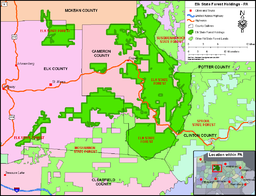Elk State Forest
| Elk State Forest | |
| Pennsylvania State Forest | |
|
Jerry Ridge Vista, Elk State Forest, in Cameron and Clinton Counties
|
|
| Country | United States |
|---|---|
| State | Pennsylvania |
| Counties | Cameron, Clinton, Elk, McKean, Potter |
| Elevation | 1,686 ft (513.9 m) |
| Coordinates | 41°20′00″N 78°17′29″W / 41.33333°N 78.29139°WCoordinates: 41°20′00″N 78°17′29″W / 41.33333°N 78.29139°W |
| Area | 200,000 acres (80,940 ha) |
| Founded | 1900 |
| Management | Pennsylvania Department of Conservation and Natural Resources |
| IUCN category | Managed Resource Protected Area (IUCN VI) |
|
Location Map of Elk State Forest Holdings
|
|
| Website: Elk State Forest | |
Elk State Forest is a Pennsylvania State Forest in Pennsylvania Bureau of Forestry District #13. The main offices are located in Emporium in Cameron County, Pennsylvania in the United States.
The forest is located on 200,000 acres (80,940 ha), chiefly in Cameron and Elk counties, with small parts of the forest also in Clinton, McKean and Potter counties.
Elk State Forest is named for the animal elk (wapiti). Although native to Pennsylvania and the area, the last wild elk in Pennsylvania was killed in 1867 near Ridgway. Elk from the Rocky Mountains were reintroduced to the area between 1913 and 1926 and the herd today has over 600 animals. This is up from a low of just 35 elk counted in the 1970s. Their range is mostly in southeastern Elk and southwestern Cameron counties. The Pennsylvania Game Commission is responsible for maintaining the elk herd in Elk State Forest and the surrounding area. In an effort to keep the herds away from agricultural areas the game commission maintains the forest in a way that suits the feeding needs of the elk. Scattered tracts of trees in the forest have been sold to lumber companies. The forest that grows in place of the harvested timber provides a variety of browse that is needed by the elk. The game commission also maintains sections of grassy areas in various locations throughout Elk State Forest providing further variety in feed for the elk.
Visitors to Elk State Forest may chance upon an elk especially during the mating season which occurs in September and October. All visitors are encouraged to keep a safe distance from any elk, but especially the bull elk who can be very dangerous during the rutting season.
The history of Elk State Forest is very similar to that of the other state forests in Pennsylvania. The land was primarily acquired from lumber companies during the early 20th century. Vast stands of old-growth forest had been harvested by the lumber companies during the mid-to-late 19th century. The earliest lumbering operations harvested the largest of the white pines for use in the shipbuilding industry. The tall and straight timbers were ideally suited for use as ships masts and spars. The logs were lashed together with rope and floated down the tributaries of the West Branch Susquehanna River and into the river on their way to the shipyards of Baltimore. Once the white pines were gone the lumbermen turned to the hemlock for use as lumber. Sawmills and lumber camps sprang up throughout what is now Elk State Forest. Much of the timber was floated down Driftwood Branch, First Fork and Bennett's Branch to the West Branch Susquehanna River and into the Susquehanna Boom near Williamsport. The lumber era in the area of Elk State Forest lasted until 1915 when the last raft was floated down the Driftwood Branch.
...
Wikipedia



